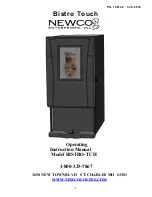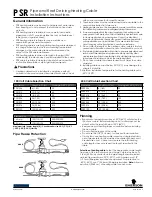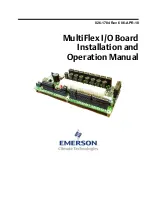
15
USER MANUAL
▪
Red Rooster Lifting Limited
▪
Nauta House, The Meadows, Oldmeldrum, Aberdeenshire, AB51 0EZ
▪
Tel: +44 (0) 1651 872101
▪
M01-AH28 REV2
SAFE OPERATION - HOIST OPERATORS
3.1
▪
Hoist operators must be healthy and not under the influence of alcohol, drugs or medication when operating the hoist.
▪
Hoist operators should be trained in the operation of hoists proper rigging procedures for the attachment of loads to the hoist.
▪
The operator is always responsible for his own safety and anybody else in the operating area.
▪
Always start the lowering or lifting movement slowly and smoothly.
▪
When using the hoist jointly with another person, use signals agreed upon at the job site (standardized signals).
▪
When using the hoist without chain collector, avoid the slack chain to fall, catch or impact as this can cause hazards.
▪
In case of air pressure loss, secure the load and area. Ensure that turning the air supply back on cannot result in a dangerous
occurrence.
▪
Stop using the hoist in case of abnormal sounds.
SAFE OPERATION - FORESEEABLE INCORRECT USE
3.1
▪
Where the supporting steel work transfers a vibration or oscillation through the hoist this can cause increased wear between the
links of the load chain.
▪
Where the hoist or hoist and trolleys are fitted with lifting points they should only be used for lifting the hoist and trolley, they are
not designed to take the full WLL of the hoist.
▪
Before carrying out any work on the hoist the main air should be turned off and the residual are vented or the hoist run to
dissipate the air pressure.
▪
Do not exceed the stated SWL or duty rating. (Fig. A)
▪
Operate the hoist smoothly. Do not suddenly change direction as this may exert both shock loads acceleration forces may well in
excess of the weight of the load being lifted.
▪
Do not use the hoist to lift / lower personnel. (Fig. B)
▪
Only use the hoist to lift a load vertically. It is not designed to pull or drag loads without modification and or a lift plan being used
for special lifting operations, such as cross hauling. (Fig. C)
▪
Ensure that the load is securely supported by its lifting gear (slings shackles etc.) and that it cannot escape whilst being lifted.
▪
Ensure that the lifting assembly (slings, shackles etc.) has a higher safe working load in the configuration used than the load to
be lifted.
▪
Ensure that the point at which the hoist is to be suspended has an equal or greater safe working load than the hoist.
▪
Ensure that the load is free to move and will clear all obstructions.
▪
Avoid swinging the load or hook.
▪
Do not use the hoist if the chain is damaged, twisted, kinked or worn.
▪
Ensure that the load is stable and in balance at starting lifting or setting down as tilting or falling loads can cause accidents.
▪
Never allow loads to “fall” into the load chain. (Fig. D)
▪
Never lock the control elements of the pendant or controls.
▪
Never use the chain, hooks or hoist as an electrical ground for welding or electricity.
▪
Do not use the limits as a means of stopping the hoist (these are safety devices).
▪
Do not use controls as a means of moving the hoist (the pendant is designed to support its own self weight only).
▪
Stand clear of the load when lifting and lowering and ensure that the point at which you are standing is safe and secure. (Fig. E)
▪
Do not hold onto the load chain when controlling a load (fit a tag to the load if necessary to ensure that the load is controlled).
▪
Do not apply a load to the tip of the Bottom Hook or the Hook Latch. (Fig. F)
▪
Do not bind a load with the load chain directly. (Fig. G)
▪
Do not operate the Load Chain while it is in contact with any sharp edges. (Fig. H)
DANGER
CAUTION
DANGER
over load
Fig. A
Fig. B
Fig. C
Fig. D
Fig. E
Fig. F
Fig. G
Fig. H
















































